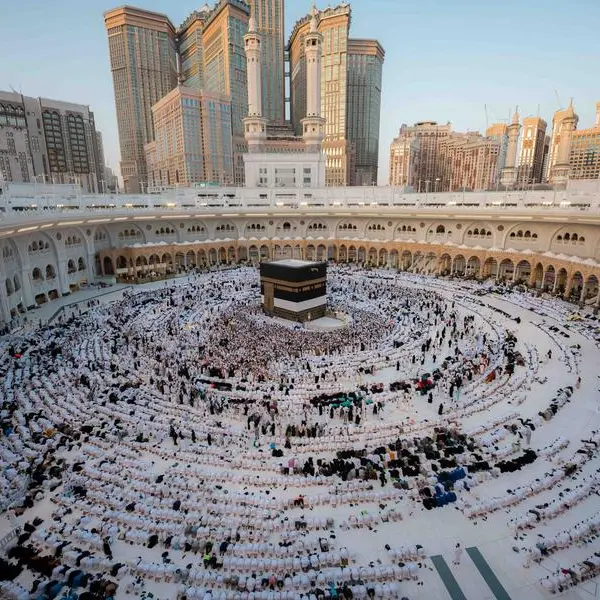PHOTO
Dubai, a city synonymous with grandeur and ambition, is internationally recognised by the monumental silhouette of the Burj Khalifa.
But beyond its towering presence lies a burgeoning art scene, enriched by Emirati culture and a bustling network of international artistic collaboration.
This post will explore how the world's tallest building has inspired Dubai's creative community and highlight the events and spaces contributing to the city's artistic renaissance.
Art in the design of the Burj Khalifa
The residential and public spaces in the building boast a myriad of artworks commissioned especially for the Burj Khalifa. These pieces, crafted meticulously by notable Middle-Eastern and international artists, provide a cultural experience that complements the building's architectural grandeur.
One example is the installation by the Korean artist Jaehyo Lee in the tower's corporate entrance. Jaehyo Lee's artwork features large discs made from natural materials like wood and stone.
On the other hand, the structure's residential entrance showcases an avant-garde sculpture by Egyptian artist Karim Rashid. The sculpture, rendered in his characteristic fluid, bold style, is a playful examination of the dichotomy between form and function that so keenly mirrors the aesthetic principle of the Burj Khalifa itself.
The hallways, lobbies, and other public spaces are adorned with works from more than 85 artists from around the globe.
Burj Khalifa - The world's largest canvas
Nestled in the heart of Downtown Dubai, the Burj Khalifa isn't just a home to residences and corporate offices.
Since its construction, the Burj Khalifa has used its status to support Dubai's burgeoning art scene.
As the clock ticked towards midnight on New Year's Eve 2017, the eyes of over a billion people were fixed on the Burj Khalifa. The occasion? Light Up 2018 was a record-shattering event in the Guinness Book of World Records for being the largest light and sound show.
The preparation for this event was immense, with more than 100,000 square meters of the building's surface area covered in LED screens, becoming a colossal exhibition space for the light show.
Emaar Properties supported the ambitious vision and AO Creative, the creative division of Arts Outdoor Lighting Technology, brought it to life.
In total, 280 moving lights and 550 fixtures were meticulously placed around the building, requiring the creative prowess of over 300 engineers, technicians, and riggers. The towering LED canvas on the Burj Khalifa came alive with patterns of Arabic calligraphy and geometric artistic designs, among other imagery.
Such was the success of the event that its run was extended beyond New Year's Eve, lighting up the Burj Khalifa for the Chinese New Year and continuing to dazzle residents and tourists alike until the end of March 2018.
Cultural and festive celebrations
Since the success of Light Up 2018, the Burj has seen numerous other light and sound shows. It lights up in red and gold for Chinese New Year, while intricate patterns illuminate the façade for Diwali. It’s also been illuminated for important world causes, such as World Autism Awareness Day when the tower lit up in blue as part of the 'Light It Up Blue' campaign.
In the past, the Burj Khalifa partnered with Emaar to allow artists to submit their work to be projected onto the tower. The LED display, composed of over a million lights, turned artist's designs into masterpieces visible from miles away.
During this event, the building's facade became a revolving exhibit, a testament to the combined transformative power of art and technology.
Dubai's wider art scene
In spring, typically in March, the prestigious Art Dubai Fair opens its doors. This annual event is crucial to the Dubai art scene, bringing together galleries, collectors, artists, and curators from across the globe.
Dubai's art scene stretches beyond the Burj Khalifa, spilling into quirky and historic neighborhoods. Alserkal Avenue has become the artistic heart of Al Quoz, a former industrial area reimagined into a creative enclave.
Not far away, the Dubai Design District, known as d3, is a testament to the city's ambitious vision, weaving together fashion, design, and architecture. This district hosts the annual Dubai Design Week.
Stepping into the Al Fahidi Historical Neighbourhood is like flipping through the pages of Dubai's past. Narrow lanes, wind-towered buildings, and the quiet charm of art galleries nestled in historic walls offer a respite from the city's futuristic hustle.
Among the city's other art venues, EDEN Gallery Dubai in Burj Khalifa Mall stands out with its vibrant and eclectic selection of artworks. Known for showcasing contemporary works from sculpture to paintings and mixed media works, EDEN Gallery has an established global reputation with galleries across New York, London, and other major world cities. Additionally, EDEN offers the convenience of buying fine contemporary artworks online through its website, extending its accessibility to art enthusiasts worldwide.
In the bustling art district of Alserkal Avenue, you'll find the Leila Heller Gallery, a space that bridges the East and West. It hosts diverse works, from Middle Eastern contemporary artists to international heavyweights. The exhibitions here tend to be thought-provoking, often reflecting on cultural and social themes.
Final thoughts
The Burj Khalifa is more than a landmark - it underscores Dubai's artistic culture. Its symbolic presence has helped to pivot the city's image from a luxury travel destination to a fertile ground for cultural expression.
Dubai's art scene has become one of the world's most exciting. It acts as a centre-point for international artistic collaboration, melding the East and West together to celebrate collaboration and diversity.
Through its influence, Dubai has constructed the world's tallest building and bridges connecting diverse cultures through the universal language of art.
Copyright © 2022 Khaleej Times. All Rights Reserved. Provided by SyndiGate Media Inc. (Syndigate.info).





















